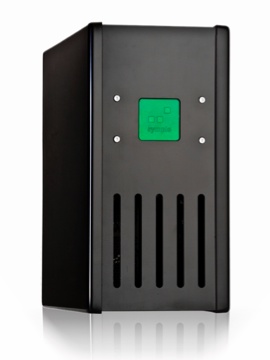There’s a new player in the preinstalled Linux world offering computers with Ubuntu preinstalled for $89, and although this price might suggest bottom of the line specs, the machines are more than powerful enough for most users. They’re also green — very green. They weigh in at 50% less than the average desktop, meaning they use less fossil fuel to ship, and are built in a case made of 100 percent recycled ABS plastic. They’re also shipped in packages completely made from non-virgin fiber.

They come from a company out of Phoenix called Symple PC, founded by Jason Spisak, who also was the co-founder and marketing director of the once popular Linux distro Lycoris, which made news back in 2003 when Walmart offered the distro preinstalled on $199 PCs. He’s now reinventing how we recycle still usable electronics by going far beyond the mere refurbishing of old boxes.
“I conceived the idea for Symple PC Web Workstations while visiting an e-waste recycling center,” he recently explained to FOSS Force. “The Snowden revelations were fresh in my mind, and I had also just watched a documentary about the scope of our global e-waste problem the day before. Walking through the place it hit me: I could bring together a need to actively mitigate e-waste and protect privacy with my passion to get Linux pre-installed on affordable computers for schools, non-profits and businesses in a single project.”
Getting businesses interested in preinstalled Linux was not new to Spisak. Although he had marginal success with the short lived Lycoris/Walmart project; other attempts had been less fruitful. “I actually visited HP on their invitation,” he said. “They wanted to see if Linux on the desktop was viable as far back as 2001. It was surreal. A couple of Linux geeks sitting in a board room discussing the lack of modem drivers inside a multi-billion dollar company.
“This has been a goal of mine for fourteen years,” he added.
The new idea is so simple (no pun intended) it’s surprising that no one’s already implemented it commercially. Symple PC has partnered with recycling centers in and around the Phoenix area, which supply it with discarded systems and parts. These then go through a multi-tier testing process before being reassembled in new cases. As much as possible is recycled, including the screws used to mount parts to the chassis.
“Testing is one of the most crucial aspects of the Symple PC,” Spisak said. “We want to make sure our customers get a solid experience, as many will judge Linux in general from their first encounter. Using Ubuntu 14.04 LTS also gives our users a supported solution for five years, something they can count on when they roll out larger numbers of units. We want people to feel safe and supported.”

“These machines are not speed demons,” Spisak admitted, “but a Symple PC gets students and workers on the web and productive. Symple takes the typically grass-roots effort lovingly performed by many school volunteers and non-profit admins and codifies it into a predictable, warrantied reality that shows up in their office or on their campus in five days.”
They may not be “speed demons,” but they’re also not lacking in resources for most purposes. Because they’re built using a variety of repurposed components, they don’t all have the same specs. However, each computer meets a minimum requirement of at least 2 GB RAM, 80 GB SATA hard drive or larger and a 2.8 GHz P4 processor or faster. Also, each Symple system will have at least one Ethernet and three USB ports and an audio out jack. The machines also have a small form factor, measuring 12.5″×12.5″×6.25″.
“The Symple PC Web Workstation represents my hope that we can change the course of our technology future towards one of privacy, freedom and respect for the planet that our fellow humans will call home long after we are gone,” Spisak said.
Christine Hall has been a journalist since 1971. In 2001, she began writing a weekly consumer computer column and started covering Linux and FOSS in 2002 after making the switch to GNU/Linux. Follow her on Twitter: @BrideOfLinux










But not in France…. 🙁
I’m not sure how green a P4 processor is. That uses power pretty heavily compared to something modern. The machine looks cute from the front, and I can envision this being nice for someone.
User reviews requested for LUG presentation. TIA
@cybergal We’re working now to see if we can get one of these to give a trial run for a review. Stay tuned. Maybe we’ll be able to work something out, which would be great.
If they’re running low-end hardware like a P4 too bad they didn’t pick something like Linux Mint with the MATE or XFCE desktop which would run much better than Ubuntu’s Unity desktop.
@Jim The specs in the article are the absolute minimum. As I understand it, most of the machines will have higher specs. I think that Ubuntu was chosen because of the brand recognition. They’re going to be marketing these primarily to schools and businesses, although everyday users like you and me can order them too. Here at FOSS Force, we’re using a desktop with a slower processor than Symple’s minimum, and it handles Ubuntu with Unity or KDE just fine — although we’re running Mint with XFCE because that’s our preference.
These could be a deal breaker for those o low incomes and trying to get online.
This is where the model will one suspects shift.
Well these are so inexpensive! The Raspberry Pi is $35 to $50. I see a lot of people going for this product and price point.
> “The Raspberry Pi is $35 to $50”
No it’s not. It is $35 for the highest model. There is no $50 Raspberry Pi.
Additionally:
While I applaud the effort, honestly I can’t see much attraction for one of these over something like a Raspberry Pi. For $35 the new Raspberry Pi 2 has:
A 900MHz quad-core ARM Cortex-A7 CPU
1GB LPDDR2
Complete compatibility with Raspberry Pi 1
4 USB ports
1 Ethernet port
HDMI out
Analog audio out
MicroSD card slot
Power consumption is ~ 3.5W
That’s pretty green. You can run several Linux distros on it or RiscOS (if you are curious), or eventually even Windows 10 (if you are insane).
I am fully in support of the basic idea expressed here. Yet I would like to point out a basic way in which the impetus for reuse is wrongly applied due to a misunderstanding of where waste enters the equation and how much/little this does to avoid waste, which I assume to be a primary goal of the project.
Waste in our industrial world is primarily generated when huge factories, full of capital equipment, human labor and energy consumption are set to work to produce poor quality goods which are purposely designed to fall apart after the warranty expires. It has been called planned obsolescence and it permeates and dominates design. Once these shoddy goods are produced, all attempts to prolong their lives are doomed because they are designed to fall apart and for the most part, will fall apart. Recycling is intended by their primary supporters, the garbage companies, to make the resulting garbage seem acceptable, even desirable, not to reuse anything. Reusing bare materials, the holy grail of recycling, is trivial and useless. However, in the cracks, as goods deteriorate, a business like this one can spring up by reusing those few components out of the torrent, that are recoverable. Reuse of higher level components is indeed far better. The river of garbage is so vast that picking out one or two percent of it can support a business, which is what is being done here. The computer refurbishing industry has a long history and this is just one more branch of that. But the real effort should be to change the design of all electronics in innovative ways to support perpetual reuse. Yes it actually can be done, once you mentally confront the challenge. Modularization and standardization are but two powerful techniques that can be applied. Learn more at the website of the Zero Waste Institute (www.zerowasteinstitute.org), especially in the Archives section. This new business is a great step, but still a baby step, compared to a better way of designing EVERYTHING for very long term reuse. Then this business can thrive, grow a hundred times larger and many new such businesses in every product line could spring up, until the barbaric concept of garbage creation could become no more than a bad memory.
@Mike – the reason for the $35-50 range for the Raspberry is having to add the shipping cost in order to get it into your hands. Best I’ve found is about $45 total.
The anticipated use is going to make the decision between a Raspberry Pi and a Symple or FreeCycle or CraigsList used computer. Or Reglue if you’re in the right place and incredibly fortunate.
I’d be reluctant to go to the effort of getting a Raspberry ready to surf the web, when the others are almost ready to go. You’ll have to provide the keyboard, mouse, and display for either, which will rise the total cost.
I have some ideas for a Raspberry that my Arduinos can’t do and be cost-efficient, so I may be in the market when I catch my wife not watching. 😉
@Paul Palmer – great coverage of those issues.
I ordered one and received it yesterday. A refurbished Compaq dc7100.
@digitalwonderbread That was quick. A one day turn around? What were the specs? Processor speed? RAM? HD? Inquiring minds want to know! 🙂
Raspberry Pi2 is not $35. It sells for about $48 (ship incl) on ebay. The $35 mentioned is relating to the British pound, not US dollar. European price $35, and US price $45 – $50.
@Paul Palmer: Very well put. Planned obsolescence sucks!
@Bro Brian
> “Raspberry Pi2 is not $35. It sells for about $48 (ship incl) on ebay. The $35 mentioned is relating to the British pound, not US dollar. European price $35, and US price $45 – $50.”
Incorrect.
http://www.mcmelectronics.com/content/en-US/raspberry-pi
@Uncle Ed > “the reason for the $35-50 range for the Raspberry is having to add the shipping cost in order to get it into your hands. Best I’ve found is about $45 total. ”
The link I listed above has $6 shipping bringing it to $41.
To compare apples to apples: What does shipping on SymplePC’s $89 computer cost? They don’t say. It seems you have to complete an order to find out.
Compaq dc7100 ~ 200W
50 Raspberry Pi 2’s would use about that much power.
🙂
You failed to mention (or didn’t notice) that mcmelectronics is having a $6 special on shipping, now through Sunday. I got an email from them yesterday telling me about it. The $45 I mentioned above was from that very source, when they were charging their regular shipping price.
You are correct that it isn’t the Pound/Dollar exchange rate that makes the price into your hands we’re quoting higher than $35. They’re $35 each,lying in the warehouse. Your actual out of pocket to own one is going to be more, but $35 US is where it starts.
You are correct that the Raspberry Pi, uses energy slower than a desktop computer, the same as my lawn mower uses energy slower than my pickup truck. But I’d hate to have to ride my lawn mower to get groceries or haul concrete blocks–it’s not suited to the “anticipated use,” the term I used above. Not thrilled about trying to mow around the garage with the truck, for that matter.
Also yesterday, I was curious and went most of the way through the SymplePC ordering process. I found it would cost about $22 to ship one to me, which would put the cost to most of the doorsteps in the USA in the $110-130 range.
I’ve tried to respond to the answerable questions you posed. I’m now wondering if it’s time for somebody to say, “Don’t feed the troll.”
@Uncle Ed
Not sure why you feel the need to compare me to a troll. I’m just trying to put up some information to help people make fair comparisons. I was pointing out that even with shipping, you are unlikely to go all the way to $50 for a Raspberry Pi. My first post was motivated by m005kennedy saying:
“Well these are so inexpensive! The Raspberry Pi is $35 to $50.”
Which is, of course, a bad comparison unless you also include shipping for the SymplePC as well. Thanks to your post we can compare prices better.
$35-45 for a Pi, vs $110-130 for a SymplePC.
I in no way suggest a Pi is as powerful as a desktop. Of course the refurbished PC is more powerful, but the Pi 2 is quite adequate as a desktop replacement in many cases. The original model was a bit slow in that department, but the 2 is quite noticeably faster and very serviceable. Saying it isn’t suited to the “anticipated use” is being disingenuous unless someone has a specific need for more power, e.g. gaming, CAD, etc.
I felt it was worth pointing out the power consumption differences since the article very clearly brought up the point about being green. It’s pretty hard to beat the Pi on green.
I got one of these, very quiet, mine is the stated minimal specs. Have tried about seven i686 linux distros, all run reasonably well, currently running Q4OS. Big bummer is the RAM, only 2GB, and if you open the case (weird security hex screws) you violate the warranty (stickers everywhere on case seams). Have spent more for slower boxes in the distant past, but this will be OK for college daughter who destroys laptops at the rate of 2-3 per year…
@Bank_of_Dad You piqued my curiosity, because I think I’d want 4 Gigs of Ram. So I went to the Symple website and read their FAQ. Yes, opening it up will void the warranty. But they also say:
—————
“Can I upgrade the hardware in it?
Absolutely, hack away! We have had folks put solid state drives in, or take the drives out all together to use them as thin clients. The PCI slots aren’t accessible, and the RAM slots vary from 2 to 4. Because of the special nature of the re-manufacturing process and warranty, once you open the Symple PC we cannot warranty it, but don’t let that stop you, after all, they are only $89.”
—————-
I’m with them on that. If this were made by Leica or Nikon or Mercedes or Rolls-Royce, I’d want my warranty intact. Reality, this is more the Yugo level.
If I get one, I’ll run it as many hours as I can for a week or so, to “burn it in.” I’ll run memory and speed tests, lots of copying and saving, and anything I can think of that kind of makes it work.
Since it’s almost entirely used parts, problems of early hardware failure are highly unlikely. About the only thing you’re testing is the assembly and “rebuild” they did. Shipping it across the country is probably the best test of whether it was assembled well If it lit up on the first try, it’s probably going to be okay.
After that week or whatever is over, it’s mine and, like Ken said on the way to surgery, cover me–I’m going in.
Re: “destroying” laptops, are your daughter’s laptops dying, rather than being physically broken? Make sure she’s not setting it down on her bed, the carpet, her lap, or other soft surface. Quite often, the cooling air intakes are on the bottom and plugging them up overheats the processor and/or the hard drive.
I had a student who came to me saying this was his third laptop that had died in a year or so. He was setting his computer on his bed while he worked. I told him to get a piece of plywood, Masonite, even very heavy corrugated cardboard to set it on and he’d never lose one that way again.
Interesting. The “minimum” specs are better than 2 out of 3 of the PCs I run here. I don’t see 2 GB as an issue. I can build a Ubuntu 14.04 Fluxbox install that boots on as little as 80 MB. But I could see this PC running Windows XP as a dedicated offline controller to my digital piano. That would free up the much newer PC connected to that piano for more useful Linux purposes.
Received my Symple PC today.
My only complaint is the fan noise… it’s so loud it’s unuseable.
I actually disconnected the case fan thinking that would resolve the issue, but now all I hear is the cpu fan churnng away. Still so loud it’s unuseable. Not kidding or exaggerating.
I wanted to use this as a ‘non-work’ stealth pc under the desk, but clearly it is not going to work for that purpose.
Other than that… what I would have expected. But that’s like asking Mrs Lincoln what she thought of the show.